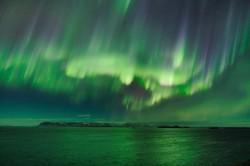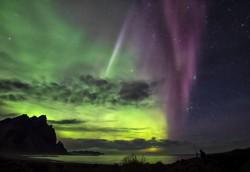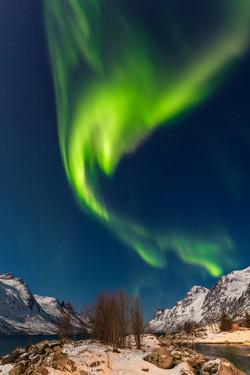Glossarbegriffe: Geomagnetischer Sturm
Description: Zusätzlich zur elektromagnetischen Strahlung der Sonne gibt es einen ständigen Strom geladener Teilchen, die die Sonne verlassen, den sogenannten Sonnenwind. Bestimmte Arten von Sonnenaktivität - Sonneneruptionen und die dramatischeren koronalen Massenauswürfe - können große Mengen an geladenen Teilchen in den Weltraum schleudern. Dabei können sie eine Schockfront im Sonnenwind erzeugen, die sich nach außen bewegt. Wenn Teile dieser Schockfront unseren Heimatplaneten erreichen, wechselwirken sie mit dem Magnetfeld der Erde und erzeugen einen geomagnetischen Sturm (manchmal auch Sonnensturm genannt). Die Folgen reichen von harmlosen - verstärkte und schönere Polarlichter (Aurorae) - bis hin zu schädlichen Wechselwirkungen, die Satelliten beschädigen, Funksignale und Satellitennavigation stören und im Extremfall Stromnetze lahmlegen können.
Zugehörige Glossarbegriffe:
See this term in other languages
Term and definition status: The original definition of this term in English have been approved by a research astronomer and a teacher The translation of this term and its definition is still awaiting approval
The OAE Multilingual Glossary is a project of the IAU Office of Astronomy for Education (OAE) in collaboration with the IAU Office of Astronomy Outreach (OAO). The terms and definitions were chosen, written and reviewed by a collective effort from the OAE, the OAE Centers and Nodes, the OAE National Astronomy Education Coordinators (NAECs) and other volunteers. You can find a full list of credits here. All glossary terms and their definitions are released under a Creative Commons CC BY-4.0 license and should be credited to "IAU OAE".
If you notice a factual or translation error in this glossary term or definition then please get in touch.
Zugehörige Medien
Iceland aurora, by Emanuele Balboni, Italy
Bildnachweis: Emanuele Balboni/IAU OAE
License: CC-BY-4.0 Creative Commons Namensnennung 4.0 International (CC BY 4.0) icons
Multicolored aurora in Iceland, by Marco Migliardi on behalf of Associazione Astronomica Cortina, Italy
Bildnachweis: Marco Migliardi on behalf of Associazione Astronomica Cortina/IAU OAE.
License: CC-BY-4.0 Creative Commons Namensnennung 4.0 International (CC BY 4.0) icons
Nordlicht-Tipis
Bildnachweis: Oanh Vuong/IAU OAE (CC BY 4.0)
License: CC-BY-4.0 Creative Commons Namensnennung 4.0 International (CC BY 4.0) icons
Nordlichtfarben
Bildnachweis: Jason Johnson/IAU OAE (CC BY 4.0)
License: CC-BY-4.0 Creative Commons Namensnennung 4.0 International (CC BY 4.0) icons
Northern light dragon over Ersfjordbotn/Norway
Bildnachweis: Rainer Sparenberg/IAU OAE
License: CC-BY-4.0 Creative Commons Namensnennung 4.0 International (CC BY 4.0) icons













